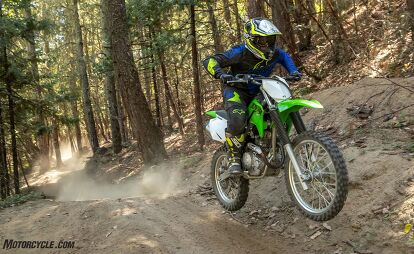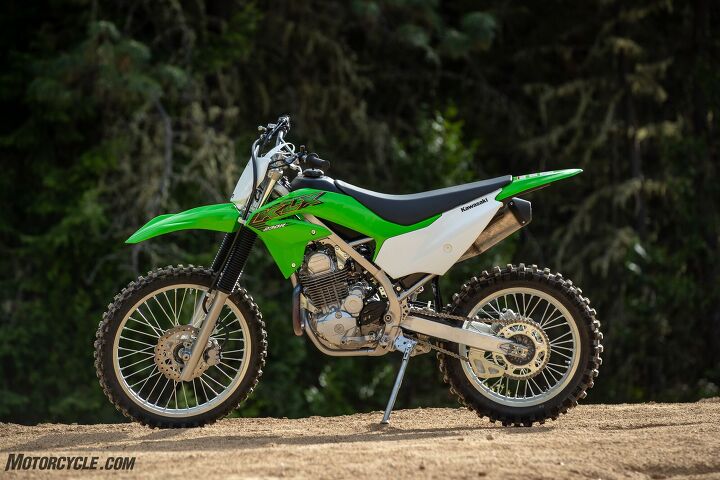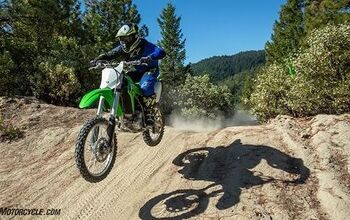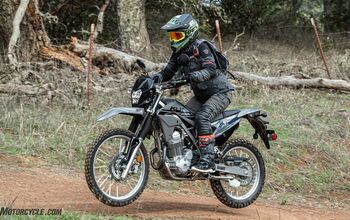2020 Kawasaki KLX230R Review - First Braap

The lightweight trailbike we've been waiting for
Similar to the street-legal KLX230 we covered last week, the 2020 Kawasaki KLX230R is designed purely for the trails. Changes are minimal between the R and it’s dual-sport sibling, though they make all the difference when riding off-road. We’re happy to see Kawasaki starting to bolster its off-road lineup with models like the new KLX230R and the KLX300R (keep an eye out for that review on the horizon as well) and hope to see the trend continue to bridge the gap between these recreational models and Kawasaki’s closed-course counterparts.
2020 Kawasaki KLX230R
| Engine | 17.0/20 |
| Suspension/Handling | 12.5/15 |
| Transmission/Clutch | 8.5/10 |
| Brakes | 8.0/10 |
| Instruments/Controls | 3.0/5 |
| Ergonomics/Comfort | 7.5/10 |
| Appearance/Quality | 9.0/10 |
| Desirability | 8.0/10 |
| Value | 9.0/10 |
| Overall Score | 82.5/100 |
2020 Kawasaki KLX230 Review – First Ride
Kawasaki sees this new KLX230R slotting in as a recreational vehicle for younger riders possibly outgrowing something the likes of the company’s KLX140 and also for less experienced or new riders all together. They also expect more experienced riders to be drawn to the KLX230R as a simple low-maintenance machine they can use as a tool, whether it be around the farm or on the back of an RV.
The KLX230R features an all-new fuel-injected 233cc air-cooled SOHC engine with a bore and stroke of 67.0mm x 66.0mm being fed by a single 32mm throttle body. Kawi says it chose the simple single overhead cam design for its power characteristics and reliability. We can’t fault them since there’s always a case to be made for simplicity of ownership, particularly so for newer and younger riders. Observant readers may note the lengthy header pipe. Kawasaki chose a longer pipe to help boost the KLX230R’s low- to mid-range performance. Even with the long header pipe’s claimed benefits, on the trail gear selection is crucial in certain situations as the motor doesn’t have an overabundance of torque. Thanks to the six-speed gear box’s slickness and light pull at the lever, shifting is as easy as a Sunday morning. Should you find yourself constantly looking for more bottom end, it’s easy enough to change sprocket sizes from the stock 46/13 gear ratio, but you’ll sacrifice top speed. I managed a top speed of 77 mph on the plated KLX230. With the gear ratio change for the R – an additional tooth up front and one less in the rear – it may not reach the same top speeds as the road-going model, but speeds north of 55 mph should be easy for most.
The KLX230R packs a lot of bike into a small package. With a wheelbase of 53.5 inches and a claimed curb weight of 253.6 lbs (258 lbs for the California model, thanks CARB), compared to 293.3 and 297.7 for the dual-sport version, the 230R feels exceedingly nimble. The R model receives an inch more suspension travel than its plated counterpart, with 9.8 inches from the 37mm fork and 9.9 from the Uni-Trak shock. Spring rates have been stiffened up as well, which made a significant difference off-road. The shock is adjustable for preload. The KLX230 felt fairly soft and was overwhelmed rather quickly once the pace ramped up off-road, whereas the R model left us all wondering why Kawi didn’t just use the same internals on the street-going model. For the folks on our ride pushing over 200 lbs with gear, the 230R still blew through the stroke, but for myself, about 180 lbs with gear, it was a significant improvement over the plated model.
A 21/18-inch wheel combo gives the KLX230R proper off-road prowess, with its ability to cruise over obstacles and maintain compliance while doing so. Theses wheel sizes also give riders plenty of options for off-road rubber, though the stock Dunlop MX52s do a great job straight off the showroom floor. Gripped by a twin-piston caliper, the 240mm front disc gets the bike slowed down efficiently while being easy to modulate, as is the case with the rear’s single-piston caliper and 220mm disc.
Ergos feel quite neutral and comfortable while seated, though some of the taller folks on our ride had an issue with the handlebars hitting their knee braces at full lock. While standing it felt like the handlebars were a bit far back and in my lap. Although I didn’t get a chance to roll the bars forward during our ride, I’m sure this would have alleviated my issues. The 36.2-inch seat height may sound lofty to those lacking of inseam, though once seated the suspension sags enough to quell the worries of shorter riders. The narrow nature of the seat and bodywork also helps riders get in contact with the ground easier than the spec sheet number might suggest.
California-bound bikes come with a keyed ignition and a 1.9-gallon steel fuel tank whereas others will be fitted with a simple on/off button for power and a plastic 1.7-gallon tank. Low fuel and FI lights are included as well as an indicator to show the bike is powered on.
Considering the competition in this category, the Kawasaki KLX230R stands out in a class of somewhat dated machinery. Things we may take for granted when looking at the market stand out in this class of trail bikes. Both the Yamaha TT-R 230 and Honda CRF230F are still carbureted and use drum-style rear brakes. Without a side-by-side comparison we don’t like to make assumptions, but it’s clear the Kawi is a more up to date package than others that have been on the market and unchanged for quite some time. The Kawasaki KLX230R also slots in right between the two aforementioned models at $4,399, $50 more than the Honda and $50 less than the Yamaha.
Our day trail riding in southern Oregon consisted of time on the KLX300R and the KLX230R, and while there is plenty to like about the larger of the two, I really enjoyed the KLX230R. The lightweight and lower center of gravity made it easy to toss the bike around on tight trails. Throttle response is smooth and linear making the 230R easy to ride without the snatchiness of more performance-focused motorcycles. The KLX230R simply felt more planted and less top heavy than the 300R, making it fun to jump and slide at every opportunity.
For riders young or old looking at the 230 range of trail bikes, the 2020 Kawasaki KLX230R is kind of a no-brainer. It’s a more up-to-date package at a great price point that will be easy to live with from a maintenance point of view. And like I mentioned in the KLX230 review, if you can’t have fun on a bike like this, you’re doing something wrong.
2020 Kawasaki KLX230R
+ Highs
- CA Green Sticker and USFS legal for year-round riding
- Fuel injection and disc brakes all around
- Lightweight
– Sighs
- Suspension could use some work for heavier and/or faster riders
- Little to no protection straight from the showroom floor
- I got nothin’ else

Helmet: 6D ATR-1 $650
- Jersey: Alpinestars Techstar Factory $60
- Pants: Alpinestars Techstar Factory $180
- Gloves: Alpinestars Techstar $44.95
- Goggles: Discontinued
- Armor: Alpinestars Bionic Pro $239.95
- Knee Braces: Asterisk Ultra Cell $759.05
Boots: Sidi Crossfire 3 $545
2020 Kawasaki KLX230R Specifications | |
|---|---|
| MSRP | $4,399 |
| Engine Type | 4-Stroke, Air-Cooled, SOHC, 2-Valve Single |
| Displacement | 233cc |
| Bore & Stroke | 67.0 x 66.0 mm |
| Compression Ratio | 9.4:1 |
| Fuel System | DFI with 32mm throttle body |
| Ignition | TCBI with Electronic Advance |
| Transmission | 6-Speed |
| Rake/Trail | 26.5°/4.4 inches |
| Front Tire | 80/100-21 |
| Rear Tire | 100/100-18 |
| Front Suspension | 37mm Telescopic Fork, 9.8 inches travel |
| Rear Suspension | Uni-Trak linkage system and single shock with adjustable spring preload, 9.9 inches travel |
| Wheelbase | 53.5 inches |
| Front Brake | 240mm petal disc |
| Rear Brake | 220mm petal disc |
| Fuel Capacity | 1.7 gallons (1.9 gallons California) |
| Ground Clearance | 11.8 inches |
| Seat Height | 36.2 inches |
| Curb Weight | 253.6 pounds / 258 pounds (CA model), claimed |
| Warranty | 6 months |
| Kawasaki | Protection Plus 12, 24, 36 or 48 months |
| Colors | Lime Green |
We are committed to finding, researching, and recommending the best products. We earn commissions from purchases you make using the retail links in our product reviews. Learn more about how this works.

Ryan’s time in the motorcycle industry has revolved around sales and marketing prior to landing a gig at Motorcycle.com. An avid motorcyclist, interested in all shapes, sizes, and colors of motorized two-wheeled vehicles, Ryan brings a young, passionate enthusiasm to the digital pages of MO.
More by Ryan Adams













































































































Comments
Join the conversation
Oh where oh where is the 2020 350 Bighorn?
This bike is not for the "taller riders". There is only every other bike for them. Find some shorter riders to test and tell the taller guys to keep their opinions.